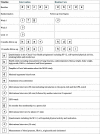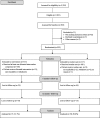Effects of a motivational, individual and locally anchored exercise intervention (MILE) on cardiorespiratory fitness: a community-based randomised controlled trial
- PMID: 30819145
- PMCID: PMC6393962
- DOI: 10.1186/s12889-019-6556-0
Effects of a motivational, individual and locally anchored exercise intervention (MILE) on cardiorespiratory fitness: a community-based randomised controlled trial
Abstract
Background: Risk factors for chronic disease, including low cardiorespiratory fitness levels (VO2max), are often present in middle-aged populations. We aimed to evaluate the efficacy of a motivational, individual, and locally anchored physical activity intervention on increasing VO2max in 30-49 year-olds with low VO2max.
Methods: 232 adult volunteers with low VO2max were randomised to intervention (n = 115) or routine care (n = 117). The intervention included four motivational interviews; six months' free membership to a local sports club; and a GPS-watch/activity monitor for uploading training data to an online platform/community. Routine care was one or two motivational interviews. Inclusion criteria were low VO2max based on the cut off levels: ≤ 39 and ≤ 35 ml O2/kg/min. For 30-39 and 40-49 year-old men respectively and ≤ 33 and ≤ 31 ml O2/kg/min for 30-39 and 40-49 year-old women, respectively. The primary outcome was change in VO2max from baseline to twelve months estimated with a maximal ergometer bicycle test. Secondary outcomes included physical activity, biochemical and anthropometric measures, and health-related quality of life. The primary analyses were based on all available data and sensitivity- and predefined sex analyses were performed. The between-group differences were estimated using independent t-tests and presented with 95% confidence intervals.
Results: No significant between-group differences in primary or secondary outcomes were found at twelve months' follow-up. The mean VO2max change from baseline in the intervention- and routine care (ml/kg/min) was 3.8 (95% CI: 2.6; 5.0) and 3.4 (95% CI: 1.7; 5.2), respectively. No changes in physical activity were observed. The mean VO2max (ml/kg/min) changes from baseline in the intervention- and routine care group in men were: 5.0 (95% CI: 3.5; 6.4) and 3.5 (95% CI: 1.5; 5.4); and in women: 1.5 (95% CI: -0.1; 3.1) and 3.4 (95% CI: -0.1; 7.8), respectively. Significant differences in VO2max between non-completers (44.2%) and completers were observed, 26.3 (95% CI: 25.1; 27.5) vs 28.2 ml/kg/min (95% CI: 27.1; 29.0; p = 0.02). Sensitivity analyses did not change the main result.
Conclusion: Offering a multi-component physical activity intervention to 30-49 year-olds with low levels of VO2max had no effect on the change in VO2max from baseline to twelve months compared with routine care.
Trial registration: ClinicalTrials.gov (no. NCT01801956 ). Registered 1 March 2013.
Keywords: Accelerometry; Community; Maximal ergometer bicycle test; Physical activity; Randomised explanatory design.
Conflict of interest statement
Ethics approval and consent to participate
The study was conducted according to the Helsinki Declaration. It was registered at
Consent for publication
Not applicable.
Competing interests
The authors declare that they have no competing interests.
Publisher’s Note
Springer Nature remains neutral with regard to jurisdictional claims in published maps and institutional affiliations.
Figures


Similar articles
-
The MILE study: a motivational, individual and locally anchored exercise intervention among 30-49 year-olds with low levels of cardiorespiratory fitness: a randomised controlled study in primary care.BMC Public Health. 2013 Dec 23;13:1224. doi: 10.1186/1471-2458-13-1224. BMC Public Health. 2013. PMID: 24365174 Free PMC article. Clinical Trial.
-
Effects of a physical activity program from diagnosis on cardiorespiratory fitness in children with cancer: a national non-randomized controlled trial.BMC Med. 2020 Jul 6;18(1):175. doi: 10.1186/s12916-020-01634-6. BMC Med. 2020. PMID: 32624004 Free PMC article.
-
Physical activity initiated by employer and its health effects; an eight week follow-up study.BMC Public Health. 2016 May 4;16:377. doi: 10.1186/s12889-016-3035-8. BMC Public Health. 2016. PMID: 27146485 Free PMC article.
-
Resistance training and inter-interindividual response differences on cardiorespiratory fitness in older adults: An ancillary meta-analysis of randomized controlled trials.Sci Prog. 2024 Jan-Mar;107(1):368504241227088. doi: 10.1177/00368504241227088. Sci Prog. 2024. PMID: 38312013 Free PMC article. Review.
-
Efficacy of Exercise Therapy on Cardiorespiratory Fitness in Patients With Cancer: A Systematic Review and Meta-Analysis.J Clin Oncol. 2018 Aug 1;36(22):2297-2305. doi: 10.1200/JCO.2017.77.5809. Epub 2018 Jun 12. J Clin Oncol. 2018. PMID: 29894274 Free PMC article.
Cited by
-
Effectiveness and Components of Health Behavior Interventions on Increasing Physical Activity Among Healthy Young and Middle-Aged Adults: A Systematic Review with Meta-Analyses.Behav Sci (Basel). 2024 Dec 19;14(12):1224. doi: 10.3390/bs14121224. Behav Sci (Basel). 2024. PMID: 39767365 Free PMC article. Review.
-
Effectiveness of physical activity monitors in adults: systematic review and meta-analysis.BMJ. 2022 Jan 26;376:e068047. doi: 10.1136/bmj-2021-068047. BMJ. 2022. PMID: 35082116 Free PMC article.
References
-
- World Health Organization . Prevention of Cardiovascular Disease - Guidelines for assessment and management of cardiovascular risk. 2007.
-
- van der Velde JHPM, Schaper NC, Stehouwer CDA, van der Kallen CJH, Sep SJS, Schram MT, et al. Which is more important for cardiometabolic health: sedentary time, higher intensity physical activity or cardiorespiratory fitness? The Maastricht Study Diabetologia. 2018;61(12):2561–2569. doi: 10.1007/s00125-018-4719-7. - DOI - PMC - PubMed
-
- Solomon E, Rees T, Ukoumunne OC, Metcalf B, Hillsdon M. The Devon Active Villages Evaluation (DAVE) trial of a community-level physical activity intervention in rural south-west England: a stepped wedge cluster randomised controlled trial. Int J Behav Nutr Phys Act. 2014;11:94. doi: 10.1186/s12966-014-0094-z. - DOI - PMC - PubMed

